What is a quick hitter in basketball
A quick hitter in the game of basketball is a type of offensive set play that utilizes a brief number of passes, cuts, screens, or dribble actions to create one or more scoring opportunities near the basket or near the perimeter, typically for the team’s best players.
Furthermore, quick hitters are usually executed during special situations during the game such as after a timeout or when the team needs a quick three-point shot before the end of the quarter.
Moreover, quick hitters are generally utilized against man to man defense but they could also be successful against zone defense or combination defense.
What is a potential advantage of quick hitters
One potential advantage of quick hitters is that they are commonly simple offensive actions that could easily generate prompt scoring possibilities as opposed to basketball offense systems or strategies which could potentially be more structured.
For example, a basic quick hitter may consist of something like player A in possession of the ball while player B cuts to get open via a basketball screen set by player C.
Afterwards, player B could receive the ball from player A and then possibly score or make plays for other teammates while player C boxes out for potential offensive rebounds or sprints into the backcourt via transition defense action.
These instant actions could be beneficial for the offensive team, especially if the primary objective is to efficiently get the ball into the hands of one of the team’s best players.
Conversely, in a system that could be at least slightly more complex such as a motion offense, the players could potentially execute a wider range of cuts, screens, or passes before taking the best available shot.
As a simple example, in the standard 5 out motion offense, the offensive players could possibly pass or cut four to seven times (or perhaps, more due to continuity action) before the highest percentage scoring option becomes available for the team as a whole.
However, with quick hitters, any of the five offensive players might potentially pass or cut about one to three times before one of those same five players swiftly attempts a shot.
What is a potential weakness of quick hitters
One potential weakness of quick hitters is that their typical simplicity might not be as effective against opposing teams with solid basketball defense fundamentals, particularly if those teams are adept in reference to pressure defense concepts and/or help defense tactics.
In other words, the quick hitters could possibly be too basic in terms of exploiting and/or breaking down opposing teams with above average defensive IQ and/or opposing teams with multiple, elite defenders.
Affiliate Disclosure: I may earn a commission on qualifying purchases made through the links below.
What are examples of 1-4 high quick hitters
Example 1 – Part 1

This is an example of a 1-4 high quick hitter that can create a scoring opportunity for the team’s low post player in addition to secondary pick and roll action. It is based on insights derived from Great Pick & Roll Plays by Lason Perkins.
To begin, 2 executes a v-cut to get open and receives the ball from 1. Following that, 5 cuts to the right side low post area via a high post cross screen set by 4.
At the same time, 3 cuts down to the left side corner. After that, 5 could receive the ball from 2 and score near the rim with a possible low post move.
Example 1 – Part 2

Next, if 5 does not receive the ball, then 2 could dribble towards the top which triggers 1 to cut towards 2.
Afterwards, 2 could execute a dribble handoff with 1. From there, 2 could cut across to the left side wing area.
Example 1 – Part 3
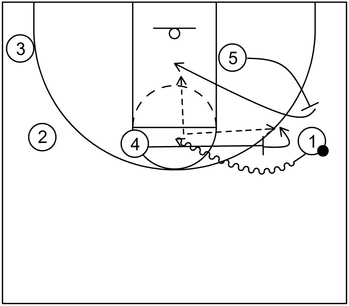
Following that action, 4 and 5 could cut towards the wing to set potential on-ball screens.
For this case, 1 could dribble towards the middle gap near the high post via the on-ball screen set by 4.
When that occurs, 5 could roll to the basket while 4 pops to the vacated right side wing.
From there, 5 could receive the ball and score near the rim or 4 could receive it instead and take the open jump shot.
It should also be noted that 1 could use the on-ball screen set by 5 instead of the screen set by 4.
Furthermore, 4 or 5 could roll to the basket while the other pops. It mainly depends on which of the two screeners have the better perimeter shooting ability.
Example 2 – Part 1
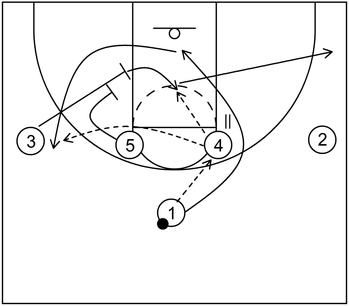
This is an example of a 1-4 high quick hitter that can create scoring opportunities for the point guard as well as potential high low action.
It is based on knowledge derived from Building the Perfect Offense by Geno Auriemma alongside additional post split action.
To start, 4 receives the ball from 1 near the right side high post elbow. Immediately after that, 1 cuts to the basket and could receive the ball from 4 via a handoff if that is open.
If that is not open, then 1 could cut across to the left side low post area for a moment. Next, 1 could cut to the left side wing area via a stagger screen set by 3 and 5.
Afterwards, 1 could receive the ball from 4 via a skip pass and take the three-point shot if open. Conversely, if the shot is not there, then 3 could cut through to the right side corner.
Example 2 – Part 2
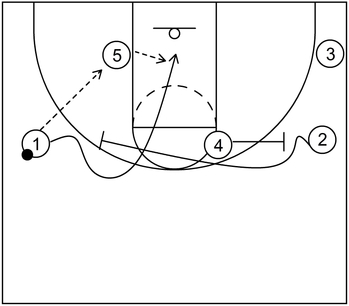
Next, 5 could receive the ball and possibly score via a low post move. However, as an alternative option, 2 could receive a screen from 4 and then 1 could execute a curl cut to the basket via a screen set by 2.
From there, 1 could receive the ball from 5 and score near the basket to complete the post split action.
What is an example of a 1-4 low quick hitter
Part 1
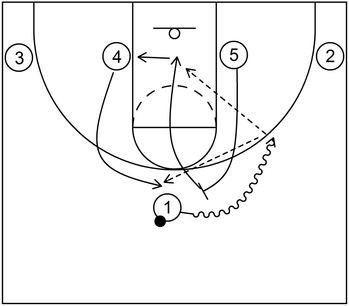
This is an example of a 1-4 low quick hitter that also includes roll and replace action between the two post players. To begin, 1 dribbles towards the right side wing via the on-ball screen set by 5.
Afterwards, 5 rolls to the basket while 4 replaces at the top. Next, 5 could receive the ball from 1 and score at the rim.
As an alternative option, 4 could also receive the ball from 1 and take the three-point shot if open.
Additionally, if 4 receives the ball but the shot is not available, then 5 could cut across to the left side low post block.
Part 2

Following that, 4 could dribble towards the left side wing and as that occurs, 3 could lift up from the left side corner towards the left side wing.
Next, 4 could execute a dribble handoff with 3.
After that, 3 could aggressively dribble into the middle gap towards the basket. From there, 5 could receive the ball from 3 and score near the rim. Moreover, 1 or 2 could also receive the ball from 3 and take open jump shots.
What is an example of a 3 out 2 in quick hitter
Part 1
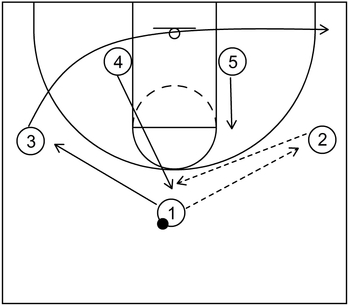
This is an example of a 3 out 2 in quick hitter which features shuffle cut action and stagger screens to produce scoring opportunities near the basket or near the perimeter.
It is derived from 15 Man-to-Man Offense Sets and Quick Hitters by Tom Moore.
To begin, 2 receives the ball from 1 and after that, 1 could cut away to the left side wing area.
Also, as that occurs, 3 cuts through to the right side corner while 4 and 5 lift up towards the top and right side high post elbow respectively. Following that, 4 could receive the ball from 2.
Part 2
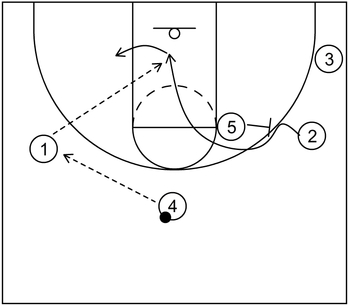
Next, 1 receives the ball from 4 and after that, 2 executes a shuffle cut to the basket.
From there, 2 could receive the ball from 1 and score at the rim. If 2 is not open, then 2 could continue the cut across the lane to the left side low post block.
Part 3
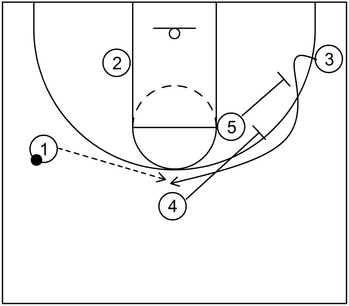
Following that, 3 could cut to the top by way of a stagger screen set by 4 and 5.
Afterwards, 3 could receive the ball from 1 and take the three-point jump shot if it is open.
Part 4
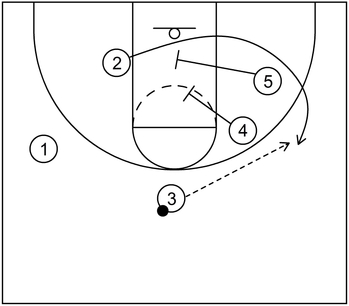
If 3 is not open for the jump shot, then 2 could cut across the lane to the right side wing via the stagger screen set by 4 and 5.
From that point, 2 could receive the ball from 3 and take the open three-point jump shot.
What are examples of 4 out 1 in quick hitters
Example 1 – Part 1
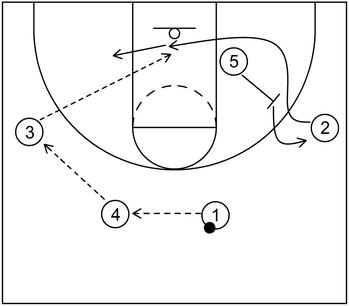
This is an example of a 4 out 1 in quick hitter which includes back screens, a flare screen, and pick and roll action to generate multiple possible scoring options.
To start, 4 receives the ball and afterwards, 3 receives it from 4. Next, 2 cuts to the basket via the back screen set by 5. Furthermore, after the back screen action, 5 replaces at the right side wing.
Following that, 2 could receive the ball from 3 and score near the rim. If that is not open, then 2 could continue the cut across the lane to the left side low post block.
Example 1 – Part 2
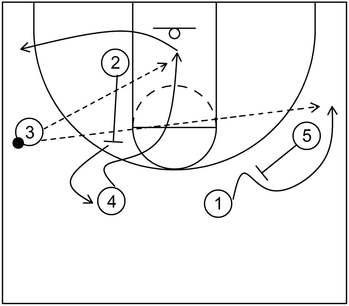
Next, 4 could cut to the basket via the back screen set by 2. Afterwards, 4 could receive the ball from 3 and score at the rim.
Also, as that happens, 1 could cut to the right side wing via the flare screen set by 5. As an alternative scoring option, 1 could receive the ball from 3 via the skip pass and take the three-point shot if open.
Additionally, if 1 receives the ball, but the shot is not there, then 4 could cut out towards the left side corner.
Example 1 – Part 3

Next, 1 could dribble towards the middle gap near the lane via the ball screen set by 5.
Moreover, after setting the ball screen, 5 could roll to the basket and receive the ball from 1 to potentially create a scoring opportunity near the rim.
Also, as alternative scoring options, 2, 3, or 4 could receive the ball from 1 and take three-point jump shots if those are available and open.
Example 2 – Part 1
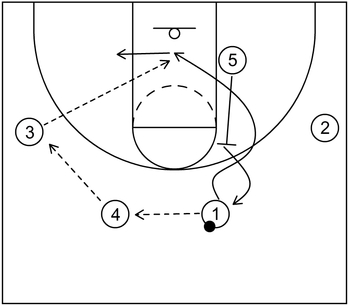
This is an example of a 4 out 1 in quick hitter which is comprised of Princeton offense elements, particularly from the Chin series, alongside an elevator screen to create a potential scoring opportunity near the rim or behind the three-point line for the team’s point guard.
To start, 4 receives the ball from 1 and following that, 3 receives it from 4. Afterwards, 1 cuts to the basket via the back screen set by 5.
Furthermore, 5 replaces at the right slot area after setting the back screen.
From there, 1 could receive the ball from 3 and score at the rim if that is open. Otherwise, 1 could cut across to the left side low post area.
Example 2 – Part 2
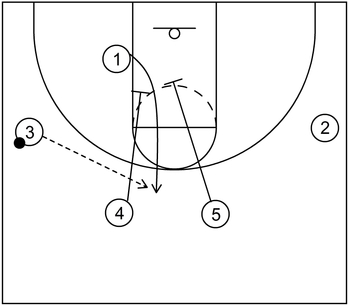
Next, 1 could execute a zipper cut to the top via the elevator screen set by 4 and 5.
Following that, 1 could receive the ball from 3 and take the open three-point shot.
What is an example of a 5 out quick hitter
Part 1
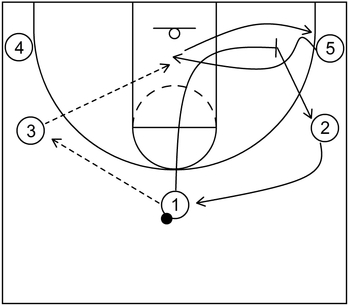
This is an example of a 5 out quick hitter which includes a flex screen to create a scoring opportunity near the basket.
To begin, 3 receives the ball from 1 and afterwards, 1 begins to cut towards the basket as with standard 5 out pass and cut action.
However, 1 cuts across the right side of the lane to set a flex screen for 5, who at the same time, cuts to the basket via that flex screen.
Next, 5 could receive the ball from 3 and score at the rim. Also, if that is not available, then 5 could execute a replace cut back to the right side corner while 2 fills to the top and 1 fills to the right side wing.
From that point, the team could continue with the pass and cut series or the pass and screen away series within the 5 out offense.
What are examples of box offense quick hitters
Example 1
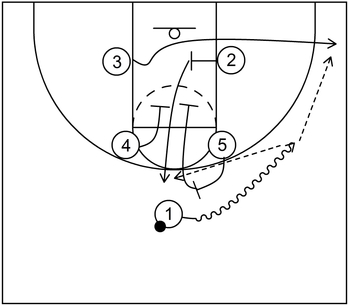
This is an example of a box offense quick hitter that features screen the screener action by way of a cross screen and an elevator screen to result in potential three-point shots.
To start, 1 dribbles toward the right side wing via the ball screen set by 5. As that occurs, 3 cuts to the right side corner via the cross screen set by 2.
Immediately following that cross screen, 2 cuts to the top via the elevator screen set by 4 and 5.
From there, 3 could receive the ball from 1 and take the open three-point shot in the right side corner. Alternatively, 2 could receive the ball from 1 instead and take the open three-point shot at the top.
Example 2
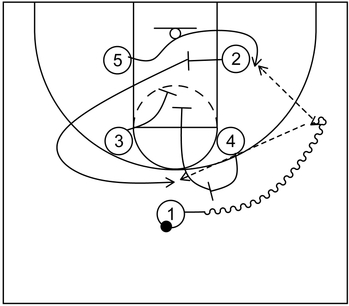
This is an example of a box quick hitter that includes screen the screener action by way of a cross screen and a stagger screen to create a possible low post scoring opportunity or three-point shot.
To begin, 1 dribbles toward the right side wing via the on-ball screen set by 4. Next, 5 cuts across to the right side low post block via the cross screen set by 2.
Immediately after that, 2 cuts to the top via a stagger screen set by 3 and 4.
From there, 5 could receive the ball from 1 and score near the basket. As a secondary option, 2 could receive the ball from 1 and take the three-point shot if open.
What is an example of a Horns offense quick hitter
Part 1
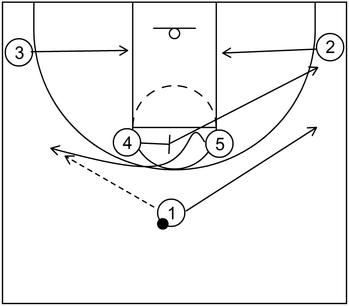
This is an example of a Horns quick hitter that could create a scoring opportunity for the team’s best low post player. It is based on insights derived from Horns Offense by Lason Perkins.
To start, 5 cuts to the left side wing area via a high post cross screen set by 4. After that, 5 receives the ball from 1.
From that point, 2 and 3 cut to the right side and left side low post block areas respectively while 4 and 1 fill the right side corner and right side wing respectively.
Part 2
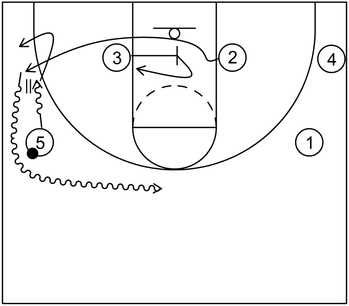
Next, 2 cuts to the left side corner via a cross screen set by 3 and as that occurs, 5 executes a dribble handoff with 2.
After receiving the ball, 2 dribbles toward the top while 3 does a self replace cut back to the left side low post block and 5 fills the left side corner.
Part 3
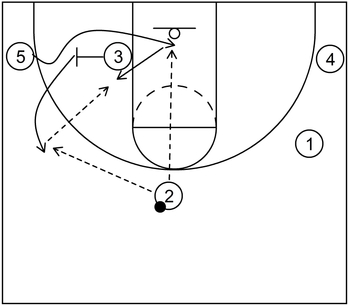
Once the ball is at the top, 5 could cut to the basket via the flex screen set by 3. Afterwards, 5 could receive the ball from 2 and score at the rim.
Also, as an alternative scoring option, if 5 is not open to receive the ball, then 3 could pop out to the left side wing.
Following that, 3 could receive the ball from 2 and then 5 could cut back to the left side low post block or briefly seal the defender under the basket.
Next, 5 could receive the ball from 3 and score near the rim via a potential low post move.
What is an example of a stack offense quick hitter
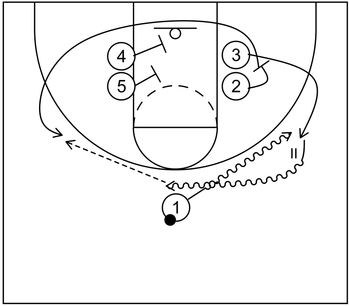
This is an example of a stack offense quick hitter that could generate a possible three-point shot for the team’s best shooter.
To begin, 1 dribbles toward the right side wing and as that happens, 3 cuts to the right side wing via the down screen set by 2.
Afterwards, 3 receives the ball from 1 via a dribble handoff and then 3 dribbles the ball back towards the top.
As that occurs, 2 cuts to the left side wing via a stagger screen set by 4 and 5.
Following that, 2 could receive the ball from 3 and take the open three-point shot.
What is an example of a quick hitter vs. a 1-3-1 zone defense
Part 1
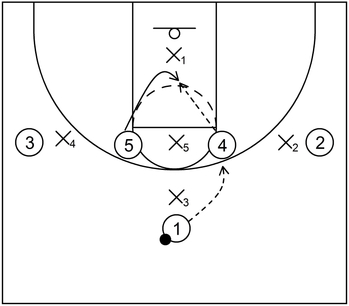
This is an example of a quick hitter vs. a 1-3-1 zone defense which utilizes a 1-4 high set alongside high low action to get the ball to the post player near the basket while potentially exploiting a mismatch.
It is based on insights taken from The Dive & Fill Zone Offense by Bob Huggins.
To start, 4 receives the ball from 1. Immediately following that, 5 cuts to the basket and seals the defender underneath.
From there, 5 receives the ball via the high low pass and scores via a low post move.
What are examples of quick hitters vs. a 2-3 zone defense
Example 1 – Part 1
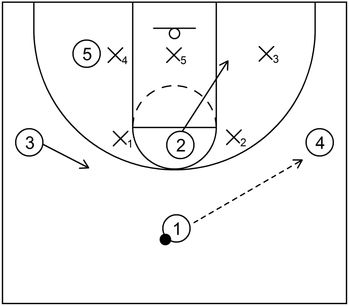
This is an example of a quick hitter vs. a 2-3 zone defense which is comprised of a corner three-pointer or a possible low post scoring opportunity. It is based on knowledge derived from The 1-3-1 Zone Offense by Tom Izzo.
To start the action, 4 receives the ball from 1 and while that occurs, 2 cuts down to the right side low post block. Furthermore, 3 slides up towards the extended left slot area as well.
Example 1 – Part 2
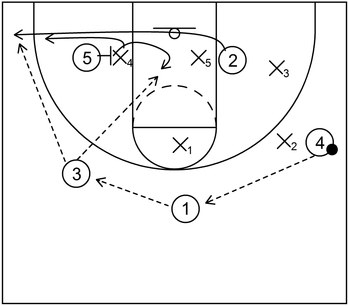
Next, 1 receives the ball and after that, 3 receives the ball from 1 to complete the ball reversal action.
As that occurs, 2 should cut to the left side corner. At the same time, 5 should have enough time to screen X4 who would normally execute a defensive closeout to the left side corner as the zone shifts from right to left.
From that point, 2 could receive the ball from 3 and take the open three-point shot in the left corner.
Also, as a secondary scoring option, if 2 is not open because X4 is able to get through the screen, then 5 could open towards the ball and seal X5 under the basket.
Afterwards, 5 could receive the ball from 3 and score near the basket with a low post move.
Example 2A – Part 1
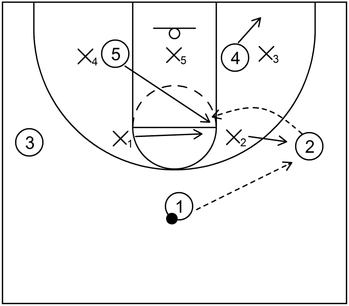
This is an example of a quick hitter vs. a 2-3 zone with a potential continuity pattern which could also be beneficial for a team with two highly skilled post players.
It is based on knowledge taken from Open Practice: Man-to-Man & Zone Offenses by Brenda Frese.
To initiate the action, 2 receives the ball from 1. After that, 5 flashes across to the right side high post elbow while 4 cuts down to the right side short corner.
From there, 5 could receive the ball from 2 if that is available.
Example 2A – Part 2
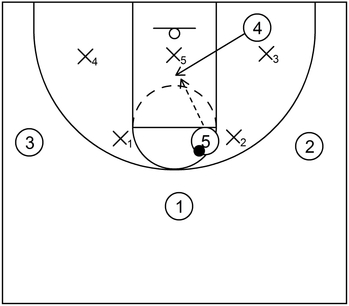
Next, 4 could cut into the lane from the short corner and seal X5 under the basket if possible. Following that, 4 could receive the high low pass from 5 and score near the rim with a potential low post move.
Example 2B – Part 1

This is a secondary option that could occur if the high low action is not available. To start, 2 receives the ball from 1 as before.
However, this time, X1 takes away the high post pass when 5 flashes to that area.
Once that happens, 4 who cut to the short corner earlier now pops to the strong side corner behind the three-point line and receives the ball from 2.
Example 2B – Part 2
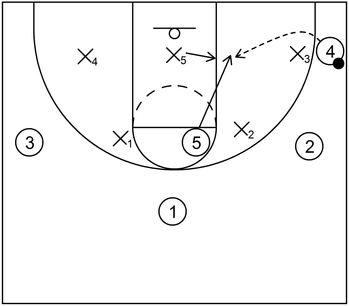
Next, 5 could cut down to the strong side low post area and receive the ball from 4. Afterwards, 5 could use a swift low post move to score near the rim.
Also, it is not shown but this action could be executed again on the opposite side of the court as a continuity pattern.
Basically, 3 would receive the ball either through standard ball reversal around the top or via a skip pass.
After that happens, 5 would cut across to the left side high post area while 4 cuts across to the left side short corner.
Next, 5 would receive the ball from 3 and then 4 would duck into the lane to receive the high low pass from 5.
If 5 could not receive the ball, then 4 would pop out to the left side corner behind the three-point line and 5 would cut down to the left side low post block.
From there, 4 would receive the ball from 3 and following that, 5 would receive the ball from 4. From there, 5 would score with a low post move near the basket.
What is an example of a quick hitter vs. a box and 1 defense
Part 1
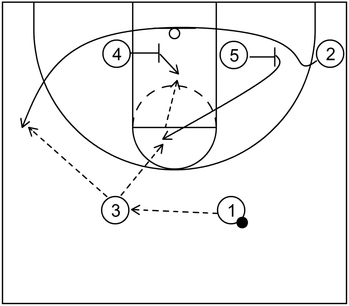
This is an example of a quick hitter vs. a box and 1 defense which could also be utilized as a continuity pattern if necessary. It is derived from Attacking the 1-3-1, 2-3 and Box-and-1 Defense by Jerry Petitgoue.
To begin, 3 receives the ball from 1 and when that occurs, 2 cuts to the left side wing via baseline screens set by 4 and 5.
Following that, 2 could receive the ball from 3 and take the three-pointer if open.
If 2 is not open to receive the ball, then 5 could flash to the high post area and receive the ball from 3.
Afterwards, 4 could briefly duck into the lane and seal the defender under the basket.
When that happens, 4 could receive the ball via the high low pass and score near the rim.
Part 2
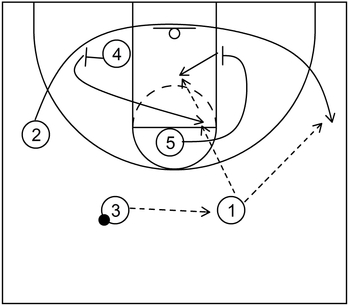
Next, if 5 could not receive the ball from 3, then 1 could receive it instead.
From there, 2 would cut through to the right side wing via the screens set by 4 and 5 near the baseline, receive the ball from 1 and take the open three-point jump shot.
If 2 is not open to receive the ball, then 4 would flash to the high post area and receive the ball from 1.
After that, 5 would duck and seal in the lane, receive the high low pass from 4, and score near the basket with a quick low post move.
If 2 or 4 could not receive the ball, then 3 could receive it again from 1 and the action would continue again on the other side of the floor.
What are examples of baseline out of bounds quick hitters
Example 1 – Part 1
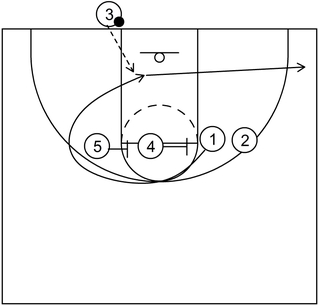
This is an example of a baseline out of bounds quick hitter that could be useful when the team needs two points or a three pointer, particularly for a post player. It is derived from Open Practice with Kelvin Sampson.
To initiate the action, 1 executes a curl cut to the basket via the high post screens set by 4 and 5.
If 1 is open on the cut, then 1 could receive the ball and score with a layup near the rim.
Otherwise, 1 could cut across the lane to the right side corner.
Example 1 – Part 2

Next, 2 could cut to the perimeter area between the left side wing and left side corner inside of the three-point line via the high post screens set by 4 and 5.
After that, 2 could receive the ball from 3 and take the open mid-range jump shot while 1 lifts up to the right side wing and 3 cuts to the right side corner.
Example 1 – Part 3
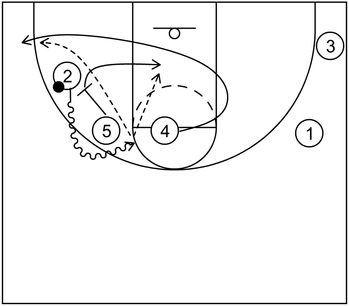
If the mid-range shot is not available, then 2 could dribble toward the high post area via the ball screen set by 5.
Immediately following that ball screen, 5 could roll to the basket while 4 circles under the roll action to the left side corner.
From that point, 5 could receive the ball from 1 and score near the rim or 4 could receive the ball instead and take the corner three-point shot if open.
Example 2
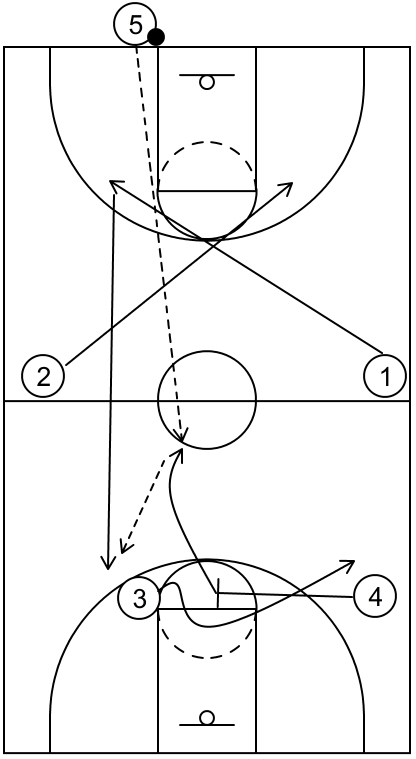
This is an example of a baseline out of bounds quick hitter that could be effective when the team takes the ball out in the backcourt and there is a need for a three-pointer with about five seconds remaining in the game.
It is derived from 20 Quick Hitters for Scoring Against Man or Zone by Jeff Walz.
To initiate the action, 3 cuts to the wing area in the frontcourt via the high post screen set by 4. However, this is mainly false action to occupy the defense.
Next, 1 and 2 perform an x-cut across the lanes with hands ready to receive the ball but this is also false action to pull the defenders of 1 and 2 further away from their own basket in the frontcourt.
While that occurs, 4 cuts toward the center circle and receives the ball via a baseball pass thrown by 5.
As the ball is in the air, 1 quickly sprints into the offensive frontcourt while the defender of 1 chases behind after being pulled away from the defensive team’s basket.
If the timing is correct, then 1 should receive the ball from 4 and be able to take the open three-point shot.
What are examples of sideline out of bounds quick hitters
Example 1 – Part 1
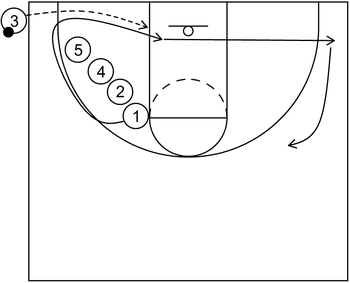
This is an example of a sideline out of bounds quick hitter, particularly when the ball is taken out near the corner of the court.
Also, this quick hitter might be beneficial if the team needs a two-pointer or three-pointer, especially at the end of a game or quarter.
It is based on information derived from Baseline to Baseline Special Situations by Fran Fraschilla.
To begin, 1 curls around 2, 4, and 5 to the basket. After that, 1 could receive the ball from 3 if that is open. Otherwise, 1 could cut through to the right side corner and then to the right side wing.
Example 1 – Part 2
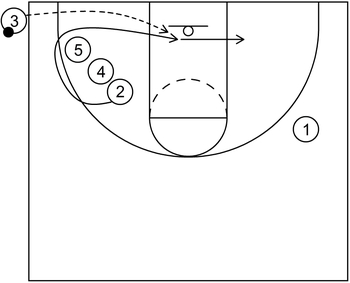
Next, 2 executes a curl cut around 4 and 5 towards the basket. Following that, 2 could receive the ball from 3 and score at the rim if that is open.
If it is not open, then 2 could simply cut across to the right side low post area.
Example 1 – Part 3

Next, 4 could fake a cut towards the basket and from there, 4 could cut back to the left side wing via a down screen set by 5.
Afterwards, 4 could receive the ball from 3 and take the open three-point shot.
Example 2 – Part 1
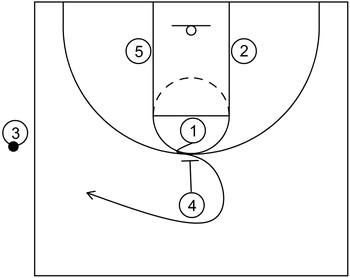
This is an example of a sideline out of bounds quick hitter that could be used particularly during the last seconds of a game or quarter when the team needs two points or three points.
It is derived from 13 End of Game & In-Bounds Plays by Steve Forbes.
To initiate the action, 1 cuts towards the ball via a down screen set by 4. However, this is currently false action to set up the next sequence.
Example 2 – Part 2

After setting the initial down screen, 4 cuts to the basket via a back screen set by 2.
If that is open, then 4 could receive the ball from 3, preferably via a lob pass over the defense, to get a quick layup or dunk.
On the other hand, if it is not open, then 4 could cut across to replace at the vacated right side low post area.
Example 2 – Part 3
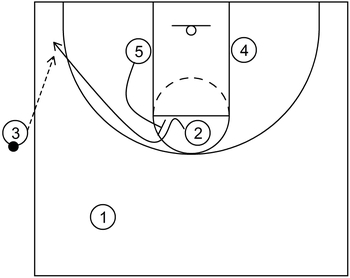
Following that, 2 could cut towards the corner via the elbow screen set by 5, receive the ball from 3, and take the open three-point shot.
Example 2 – Part 4
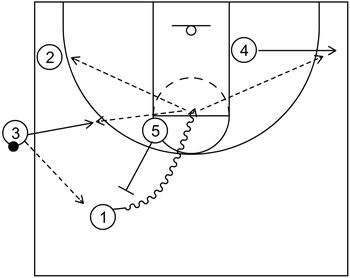
If 2 is not open, then 1 could finally receive the ball from 3. Next, 1 could dribble towards the basket via the angle ball screen set by 5.
At the same time, if the team still needs to shoot a three-pointer, then 4 could flatten out to the right side corner.
From there, 2, 3, or 4 could receive the ball from 1 and take respective three-point shots if necessary.